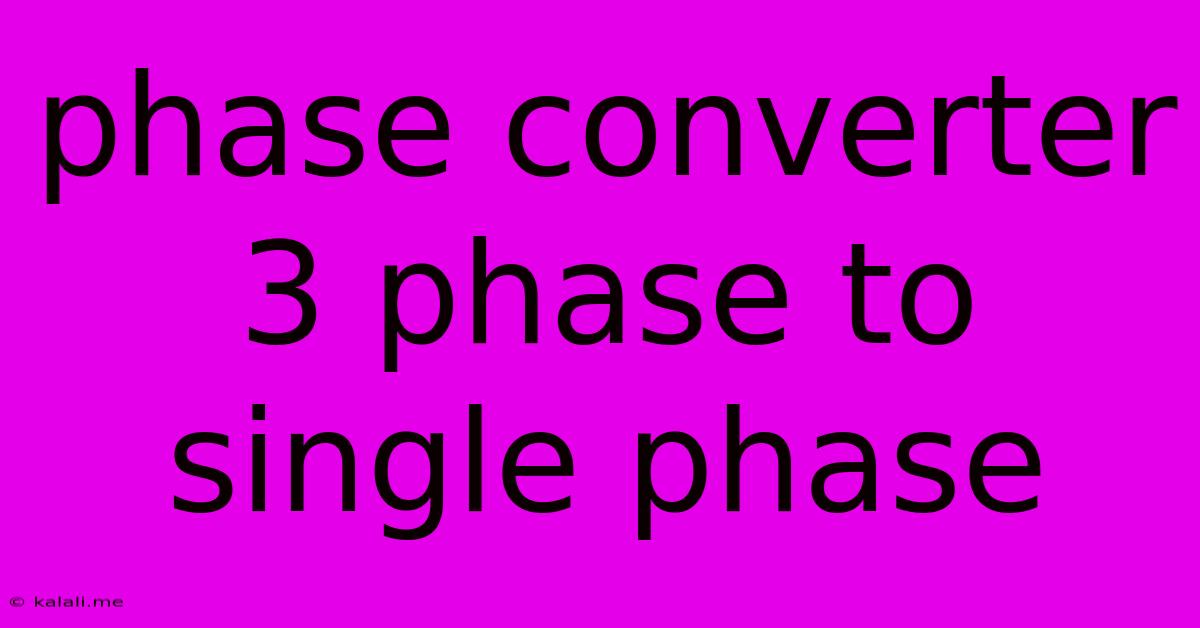Phase Converter 3 Phase To Single Phase
Kalali
May 29, 2025 · 3 min read

Table of Contents
Converting 3-Phase Power to Single-Phase: A Deep Dive into Phase Converters
Meta Description: Need to run single-phase equipment on a three-phase power supply? This comprehensive guide explains how phase converters work, their types, applications, and factors to consider when choosing one. Learn about rotary converters, static converters, and more.
Running single-phase equipment in a three-phase environment is a common challenge faced by many industries and even homeowners with workshops. The solution lies in a phase converter, a device that transforms three-phase power into usable single-phase power. This article will explore the intricacies of phase converters, their different types, applications, and essential considerations for selection.
Understanding Three-Phase and Single-Phase Power
Before delving into phase converters, understanding the fundamental differences between three-phase and single-phase power is crucial. Three-phase power consists of three alternating current (AC) waveforms, each 120 degrees out of phase with the others, offering higher power capacity and efficiency. Single-phase power, on the other hand, utilizes only one AC waveform. Many industrial machines and larger power tools operate on three-phase power, while household appliances typically run on single-phase power.
Types of Phase Converters
Phase converters are broadly classified into two main categories:
-
Rotary Phase Converters: These converters utilize a motor-generator set to transform three-phase power. A three-phase motor drives a generator that produces single-phase power. Rotary converters are known for their high efficiency and ability to handle high starting loads. They are typically more expensive but offer superior performance, especially for larger equipment. They also provide a cleaner, more stable single-phase output. Different designs within this category exist, with some incorporating capacitors for improved power factor correction.
-
Static Phase Converters: These converters use electronic components, such as capacitors, inductors, and sometimes solid-state switches, to convert three-phase power to single-phase. Static converters are generally less expensive than rotary converters but may exhibit lower efficiency and have limitations in handling high starting currents. They are a popular choice for smaller applications where cost is a primary concern. Different configurations exist within the static converter category, each offering a trade-off between cost, efficiency, and performance.
Choosing the Right Phase Converter: Key Factors
Selecting the appropriate phase converter depends on several critical factors:
-
Power Requirements: The size of the single-phase equipment you intend to power dictates the necessary capacity of the phase converter. This is usually expressed in kilovolt-amperes (kVA) or horsepower (HP).
-
Starting Load: Consider the starting current of your single-phase equipment. Rotary converters generally handle high starting loads better than static converters.
-
Budget: Rotary converters typically have a higher upfront cost than static converters.
-
Efficiency: Rotary converters generally offer higher efficiency, leading to lower operating costs in the long run. This is especially important for continuous operation.
-
Application: The specific application will influence the choice. For heavy-duty industrial machinery, a rotary converter might be necessary, while a smaller workshop might benefit from a more cost-effective static converter.
-
Maintenance: Rotary converters require more regular maintenance than static converters due to the moving parts.
Applications of Phase Converters
Phase converters find applications in various settings:
- Industrial settings: Running single-phase equipment in factories and workshops with three-phase power supply.
- Agricultural settings: Powering single-phase machinery in farms.
- Construction sites: Providing single-phase power for tools and equipment.
- Workshops and garages: Enabling the use of single-phase tools in locations with three-phase power.
Conclusion
Choosing the right phase converter requires a thorough understanding of the different types available, their capabilities, and your specific needs. By carefully considering the factors discussed above, you can select a phase converter that efficiently and reliably converts three-phase power to single-phase, allowing you to operate your single-phase equipment effectively. Remember to always consult with a qualified electrician for installation and safety concerns.
Latest Posts
Latest Posts
-
How To Get Squirrels Out Of The Attic
May 30, 2025
-
Why Was Blood Put On Aarons Right Ear
May 30, 2025
-
How To Grow A Cherry Tree From Seed
May 30, 2025
-
Why Is My Elephant Ear Turning Yellow
May 30, 2025
-
How Do You Say By In Japanese
May 30, 2025
Related Post
Thank you for visiting our website which covers about Phase Converter 3 Phase To Single Phase . We hope the information provided has been useful to you. Feel free to contact us if you have any questions or need further assistance. See you next time and don't miss to bookmark.